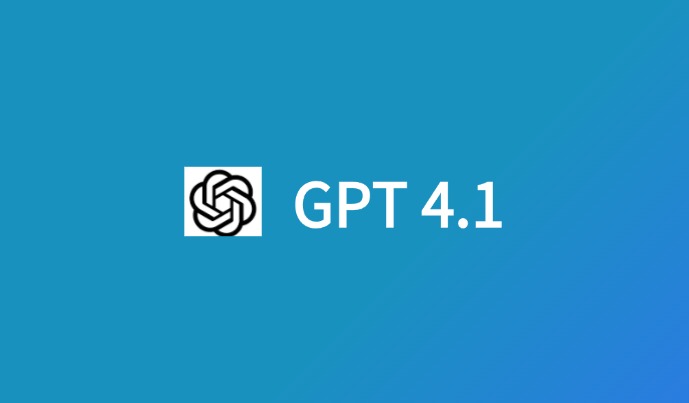Introduction to AI Knowledge Bases
What is an AI Knowledge Base?
An AI knowledge base is more than a repository—it’s an intelligent, self-evolving system powered by artificial intelligence to store, organize, and retrieve information dynamically. Unlike traditional databases that passively hold data, AI knowledge bases use advanced algorithms to understand context, infer relationships, and deliver tailored insights. Think of them as a digital brain: they ingest raw information—text, images, audio, or even handwritten notes—and transform it into actionable knowledge through machine learning and natural language processing (NLP). From answering complex queries to generating reports, these systems are designed to think alongside you, adapting to your needs over time.
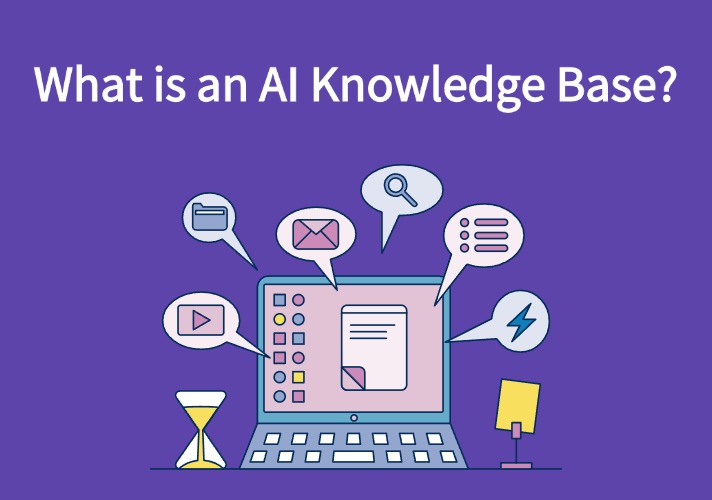
Why AI Knowledge Bases Matter in the Modern World
We live in an age of unprecedented data growth—by 2025, global data creation is projected to exceed 180 zettabytes annually, according to IDC. This deluge overwhelms traditional tools, leaving individuals and organizations struggling to find signal in the noise. AI knowledge bases matter because they act as a filter and amplifier, cutting through irrelevant information to deliver precise, timely answers. They’re revolutionizing industries: doctors use them to sift through medical journals, businesses leverage them for market insights, and students rely on them to organize coursework. In a world where time is currency and decisions shape outcomes, AI knowledge bases aren’t just helpful—they’re indispensable. Here’s provides a more detailed introduction to AI knowledge bases. → What Is an AI Knowledge Base? Ultimate Guide to 2025
How AI Knowledge Bases Work
Core Mechanisms: Data Ingestion, Processing, and Retrieval
At their heart, AI knowledge bases operate through a three-stage cycle. First, data ingestion pulls in information from diverse sources—think PDFs, web pages, emails, or voice recordings—converting them into a unified format. Next, processing employs AI to analyze this data, identifying patterns, extracting key points, and building connections (e.g., linking a research paper to a related news article). Finally, retrieval delivers answers via user queries, often in natural language, with results ranked by relevance. This isn’t static storage—it’s a living process where the system refines itself with each interaction.

Role of Machine Learning and Natural Language Processing (NLP)
Machine learning (ML) is the engine driving adaptability. Supervised and unsupervised models learn from data patterns, improving accuracy over time—say, recognizing that “stock trends” and “market analysis” are related. NLP, meanwhile, bridges human communication and machine understanding. It parses your questions (“What’s the latest on renewable energy?”) and generates coherent, conversational responses. Together, ML and NLP make AI knowledge bases not just smart, but intuitive—capable of handling ambiguity and context like a human assistant.
Real-Time Updates and Continuous Learning
What sets AI knowledge bases apart is their ability to evolve. Real-time updates mean new data—whether a breaking news article or a freshly uploaded report—is integrated instantly, keeping the system current. Continuous learning takes this further: as you interact, the AI refines its understanding of your preferences and priorities. For example, if you frequently ask about financial forecasts, it’ll prioritize economic data in future responses. This dynamic nature ensures relevance in fast-moving fields like tech or medicine.
How iWeaver Adapts and Learns from Personal Data
Consider iWeaver, a standout in this space. It starts by collecting your personal inputs—web clippings, meeting notes, research PDFs, even audio transcripts—building a private knowledge base unique to you. Its adaptive learning kicks in as you use it: if you’re a consultant who uploads client reports, iWeaver learns your jargon, preferences, and goals, tailoring outputs like summaries or mind maps. The more you feed it, the smarter it gets, transforming scattered data into a personalized productivity tool.
AI Knowledge Bases vs. Traditional Knowledge Bases
Key Differences in Structure and Functionality
Traditional knowledge bases are like filing cabinets: static, manually curated collections of documents or FAQs, searchable but rigid. AI knowledge bases, by contrast, are like librarians with PhDs—they actively process data, infer meaning, and adapt to queries. Structurally, traditional systems use fixed hierarchies (e.g., folders), while AI systems employ flexible models like semantic graphs. Functionally, the former offers basic retrieval; the latter provides synthesis, prediction, and conversation.
Advantages and Limitations of Each Approach
Traditional bases are simple, cost-effective, and reliable for stable, well-defined needs—like a company’s policy manual. But they falter with scale or complexity, requiring constant human upkeep. AI knowledge bases shine in dynamic environments, offering speed, scalability, and insight generation—though they demand robust data inputs and higher initial investment. A poorly fed AI system risks “garbage in, garbage out,” while a neglected traditional base just sits unused.
Why AI Knowledge Bases Are Essential
Addressing Information Overload
The average professional receives 120 emails daily and sifts through countless articles, reports, and updates. AI knowledge bases tackle this by filtering out noise—highlighting what’s critical and ignoring the rest. They’re a lifeline in a sea of data.
Enhancing Decision-Making and Efficiency
Speed and precision define modern success. AI knowledge bases deliver insights fast—imagine a CEO querying market data and getting a synthesized report in seconds. Efficiency soars as repetitive tasks (e.g., summarization) are automated, freeing time for strategy and creativity.
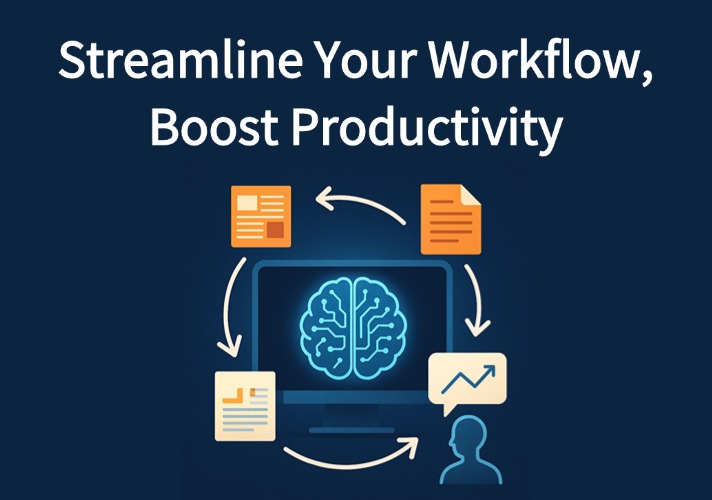
Supporting Innovation Across Industries
In healthcare, AI systems analyze studies to suggest treatments; in finance, they predict trends; in education, they personalize learning. By connecting disparate data points, they spark breakthroughs—turning raw info into actionable ideas.
Example: iWeaver’s Role in Streamlining Professional Workflows
Picture a financial analyst facing a tight deadline. With iWeaver, they upload 20 market reports, ask for a trend analysis, and receive a concise summary with charts—all in minutes. This isn’t just efficiency; it’s a competitive edge. Try this tool → AI Document Summarizer
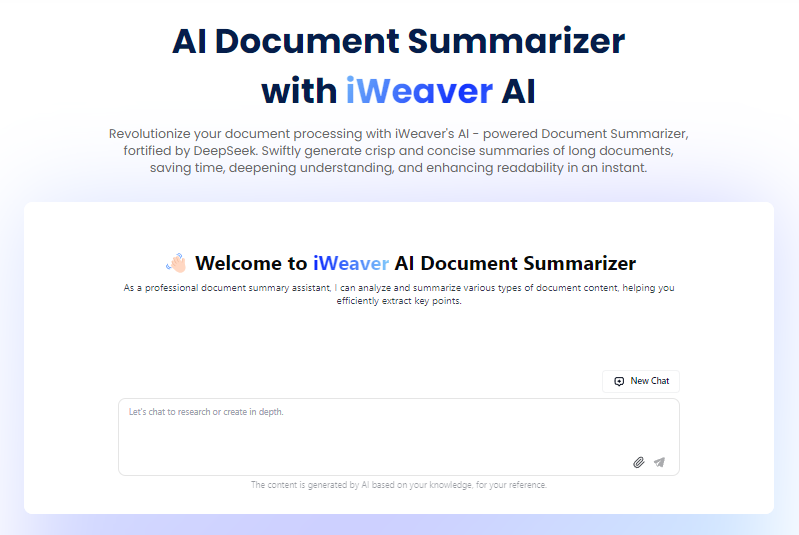
Key Components of an AI Knowledge Base
Data Sources and Integration
Diversity is key—AI systems pull from texts, images, audio, and more. Integration unifies these into a cohesive whole. iWeaver, for instance, supports nine formats (PDFs, screenshots, recordings), seamlessly blending them into your knowledge hub.
Knowledge Representation (e.g., Ontologies, Graphs, iWeaver’s Topic-Based Systems)
Data needs structure. Ontologies define terms (e.g., “revenue” as a financial concept); graphs link ideas (e.g., “solar energy” to “policy”). iWeaver adds a twist with topic-based systems, organizing knowledge around your projects or interests—like a “Market Research 2025” cluster.
AI Algorithms and Models
These are the brains—ML models for learning, NLP for language, and reasoning algorithms for connecting dots. They turn raw data into insights, powering everything from search to synthesis.
User Interface and Accessibility Features
A sleek UI with natural language input (e.g., “Show me last month’s notes”) and accessibility options (e.g., voice commands) ensures the system fits all users, from tech novices to experts.
Types of AI Knowledge Bases
AI knowledge bases come in flavors, each with unique strengths:
| Type | Description | Strengths | Use Case | Examples |
|---|---|---|---|---|
| Rule-Based | Relies on predefined logic and rules | Predictable, task-specific | Troubleshooting guides | Expert systems |
| Semantic | Uses relationships and meaning for rich context | Broad, contextual queries | General research | Google Knowledge Graph |
| Hybrid | Merges rules and semantics for balance | Versatile, precise | Enterprise analytics | IBM Watson |
| Personal Adaptive | Grows with user data for tailored insights | Personalized, workflow-driven | Professional productivity | iWeaver |
Rule-Based Knowledge Bases
Built on “if-then” rules, they’re ideal for structured, repetitive tasks—like diagnosing tech issues.
Semantic Knowledge Bases
They excel at understanding meaning, linking concepts across domains—perfect for exploratory queries.
Hybrid Knowledge Bases
Combining both, they tackle complex needs with flexibility and depth.
Personal Adaptive Knowledge Bases: iWeaver as a Case Study
iWeaver redefines the category by adapting to your life—collecting your notes, reports, and ideas, then serving up custom outputs like mind maps or analyses.

Target Audiences for AI Knowledge Bases
AI knowledge bases cater to heavy knowledge management groups, each facing unique challenges that these systems adeptly solve.
Financial Professionals
Challenges: Financial analysts, traders, and advisors grapple with an avalanche of market reports, regulatory updates, and economic data—often scattered across platforms. Tight deadlines and the need for rapid, accurate insights compound the pressure, while missing a key trend can cost millions.
Solutions: An AI knowledge base centralizes this data, offering instant summaries, trend analyses, and predictive insights. It reduces research time by synthesizing reports, flags critical shifts (e.g., interest rate changes), and supports data-driven decisions with precision—empowering professionals to stay ahead in volatile markets.
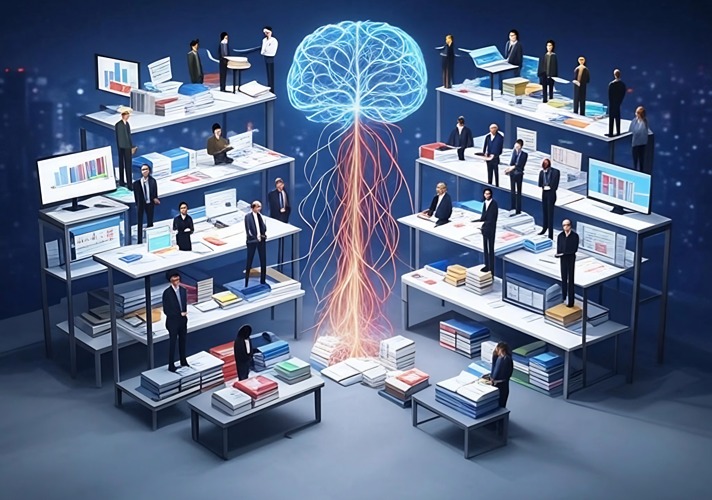
Academic Researchers
Challenges: Researchers juggle vast libraries of papers, books, and notes, often losing track of sources or struggling to recall faint connections between studies. Manual synthesis is time-consuming, and deadlines for grants or publications loom large.
Solutions: AI knowledge bases store and organize this material, enabling quick retrieval of past insights (e.g., “What did that 2019 study say about gene editing?”) and generating thematic overviews. They accelerate literature reviews, connect ideas across disciplines, and free researchers to focus on discovery rather than administration.
Consultants
Challenges: Consultants face diverse client needs, requiring rapid digestion of industry reports, meeting notes, and historical data. Producing tailored proposals under tight timelines is a constant struggle, compounded by fragmented knowledge across projects.
Solutions: An AI knowledge base consolidates this info, recalling past solutions for similar clients and producing polished deliverables fast. It streamlines workflows by summarizing discussions or drafting frameworks, ensuring consultants deliver high-value insights without drowning in details.
Content Creators
Challenges: Writers, journalists, and marketers manage inspiration from articles, books, and interviews, but ideas get buried in cluttered notes. Deadlines demand quick access to references, and repetitive research saps creative energy.
Solutions: AI knowledge bases archive this material, retrieving fuzzy memories (e.g., “That quote about innovation…”) and suggesting content outlines based on stored data. They enhance productivity by automating research and ideation, letting creators focus on crafting compelling narratives.
Real-World User Case Studies
Here are three book-related use cases showcasing how AI knowledge bases transform workflows:
Case Study 1: Storing Knowledge and Recalling Fuzzy Memories
Scenario: A historian writing a book on medieval trade routes uploaded notes, maps, and 15 books (e.g., PDFs of The Silk Roads by Peter Frankopan) into an AI knowledge base. Months later, they vaguely recalled a detail about spice tariffs but couldn’t pinpoint the source.
Solution: The AI system stored all inputs securely, indexing them for easy access. When queried—“What did I read about spice tariffs?”—it scanned the personal archive, retrieved a passage from The Silk Roads, and highlighted related notes, saving hours of manual searching. This seamless recall turned a fuzzy memory into a concrete citation.
Case Study 2: Personalized Answers That Evolve with Use
Scenario: A novelist drafting a sci-fi book fed their AI knowledge base with research books like Dune by Frank Herbert and notes on planetary ecosystems. They asked, “How can I describe a desert planet’s economy?” early on, then again after adding more data over six months.
Solution: Initially, the system offered a basic response based on Dune. Later, with more inputs, it provided a richer answer, weaving in user notes and adapting to their style—e.g., suggesting trade networks tied to water scarcity. The more they used it, the better it understood their creative voice, proving its growing intelligence.
Case Study 3: Task-Oriented Multi-Tasking
Scenario: A business author working on a leadership book uploaded texts like Good to Great by Jim Collins and meeting notes, needing a summary, a mind map, and a draft chapter simultaneously under a tight deadline.
Solution: The AI knowledge base, task-oriented by design, processed the request efficiently. It summoned specialized tools—an agent for summarization, another for visualization, and a third for writing—delivering all three outputs in parallel. The summary distilled key principles, the mind map linked concepts, and the draft kickstarted the chapter, showcasing its ability to juggle multiple tasks with precision.
Lessons Learned from Successful Implementations
These cases highlight that storing knowledge systematically, recalling past insights effortlessly, personalizing responses over time, and handling tasks with integrated tools are pivotal to success, meeting real-world demands effectively.

How to Choose the Right AI Knowledge Base for Your Needs
Assessing Your Goals and Requirements
Start by defining your priorities. Do you need a system that handles diverse data types—text, audio, images—or one that excels at recalling past insights from a personal archive? Are you after rapid task execution (e.g., summarizing 20 files) or deep personalization that evolves with use? Pinpoint whether speed, depth, or adaptability matters most to your workflow.
Comparing Open-Source vs. Commercial Solutions
Open-source options like Haystack offer flexibility but require technical know-how and setup time. Commercial solutions streamline this with pre-built features—like support for multiple file formats, automated task processing, or adaptive learning—ideal if you value plug-and-play efficiency. Consider whether you’re willing to trade customization for a polished, ready-to-use experience that saves time upfront.
Scalability, Cost, and Support Considerations
Think long-term: can it grow from personal use to team collaboration without performance dips? Look for unlimited storage to handle years of data, and weigh initial costs against ongoing value—some systems bundle advanced features (e.g., multi-agent task handling) at a flat rate. Reliable support is key too—ensure help is available for setup or troubleshooting, especially if your work depends on seamless operation.
Challenges and Future Trends in AI Knowledge Bases
Overcoming Data Quality and Bias Issues
The promise of AI knowledge bases hinges on the quality of their inputs—poor data leads to skewed or unreliable outputs, a classic case of “garbage in, garbage out.” For instance, if a financial analyst’s knowledge base is fed outdated market reports or biased datasets, its predictions could mislead rather than inform. Ensuring robust data cleaning, validation, and diversity is a persistent challenge, requiring ongoing effort to maintain accuracy. A Harvard Business Review analysis warns that unchecked bias in AI systems can erode trust and amplify errors, particularly in high-stakes fields like medicine or finance. Addressing this demands not just technical fixes but also a commitment to ethical data practices, ensuring the system’s insights remain dependable as it scales.
Emerging Innovations: AI Orchestration, Multi-Tasking, Personalization, Task Orientation, and Productivity Gains
The future of AI knowledge bases is brimming with transformative potential, driven by several interconnected trends that promise to elevate their utility and impact.
- AI Orchestration: Imagine an AI knowledge base as a conductor, directing a symphony of specialized agents—each tuned to a specific task like summarizing, analyzing, or drafting. This orchestration enables seamless collaboration among components, streamlining complex workflows. For example, a researcher could upload a dozen studies and, with one command, trigger a cascade of actions: one agent extracts key findings, another builds a mind map, and a third drafts a report—all synchronized effortlessly. This trend is pushing AI beyond isolated functions into a cohesive, intelligent system that amplifies human effort.
- Simultaneous Multi-Task Processing: The ability to handle multiple tasks concurrently is redefining efficiency. Picture a consultant preparing for a client pitch: their AI knowledge base processes 20 documents at once—generating a summary, identifying trends, and crafting slides in parallel—rather than sequentially. This multi-tasking capability slashes turnaround times, turning hours of work into minutes. It’s not just speed; it’s the capacity to juggle diverse demands without losing precision, a leap forward for time-sensitive professions like finance or content creation.
- Increasing Personalization (“Getting to Know You Better”): Future AI knowledge bases will deepen their understanding of users over time, evolving from generic tools into intuitive partners. By analyzing your inputs—say, books, notes, or queries—the system learns your habits, preferences, and goals, tailoring responses to fit you perfectly. A writer asking “How do I structure my novel?” might get a suggestion shaped by their past work, while a trader gets market insights aligned with their risk profile. This growing intelligence—where the AI “knows you” better with each use—creates a feedback loop of relevance and trust, making it a true extension of your mind.
- Task Orientation: The shift toward task-driven design is a game-changer. Instead of merely storing data, future systems will focus on outcomes—executing specific goals like “analyze my competitor’s strategy” or “draft my thesis chapter.” They’ll summon the right tools—be it text analysis, visualization, or external APIs—to deliver results directly, bypassing unnecessary steps. This orientation aligns the AI with your workflow, ensuring it’s not just a database but a proactive ally in achieving tangible results.
- Boosting Productivity: At the heart of these innovations lies a singular aim: elevating productivity. By orchestrating tasks, processing them simultaneously, personalizing outputs, and focusing on goals, AI knowledge bases are poised to save hours of repetitive work—potentially cutting research or prep time by 70%, as hinted by tools like iWeaver with its multi-agent evolution. A Forbes article suggests that such advancements could boost workplace efficiency by 30-40%, freeing users to focus on creativity and strategy over grunt work. For instance, a marketer could go from raw data to a polished campaign plan in a fraction of the usual time, leveraging an AI that anticipates their needs and delivers fast.
iWeaver offers a glimpse of this future—its multi-agent system already hints at orchestration and task-focused processing, adapting to users with each interaction. As these trends mature, AI knowledge bases will become not just tools, but indispensable collaborators, reshaping how we work and think in an increasingly complex world.
Ready to simplify your world? Explore tools like iWeaver—start small, experiment, and unlock your potential today.



